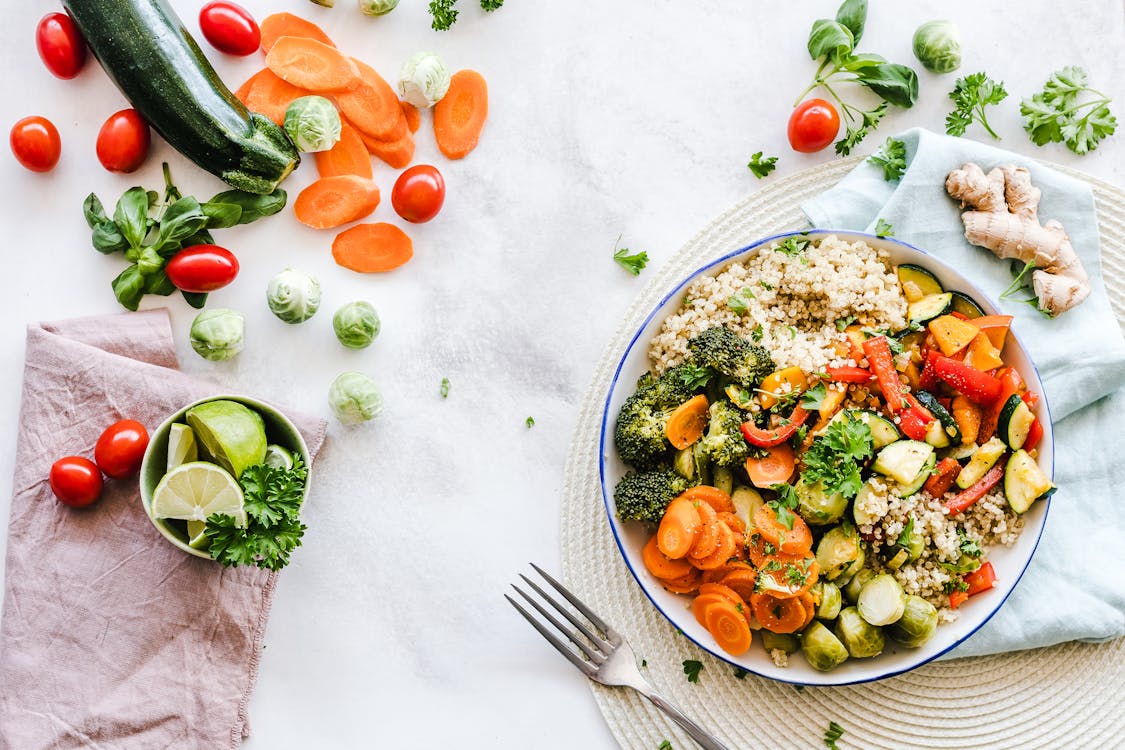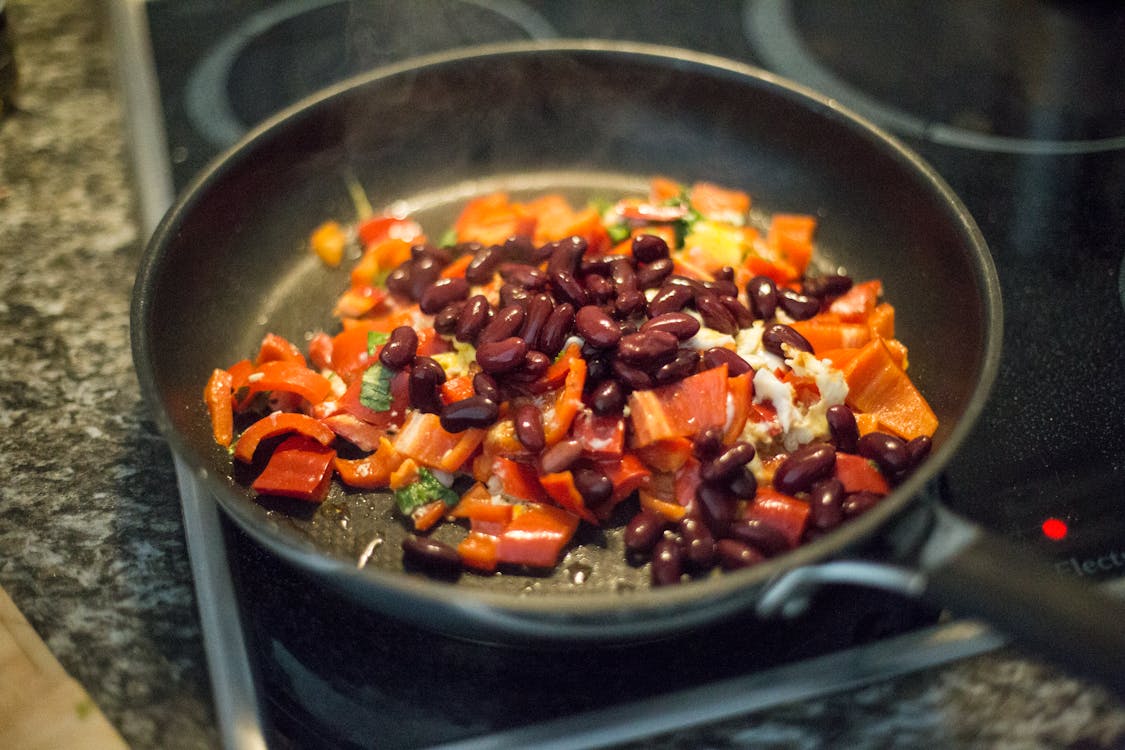We hear it all the time: "Eat more fibre", but many people don't fully understand what this means - they think fibre is just something to do with their internet connection! If this is you, don't worry - in this article, you'll find out what dietary fibre is, why fibre is so important for good health, and how you can add more fibre to your diet. Even if you're already a fibre fanatic, you'll still find some helpful tips and information.
What is dietary fibre?
Fibre is a type of indigestible carbohydrate found naturally in plant-based foods, the bits like the skins, seeds, and pith in fruits and vegetables, or the husks of grains. Unlike other food components, such as fats, proteins or carbohydrates, which your body breaks down and absorbs, fibre can't be fully broken down by digestive enzymes. Instead, it passes relatively intact through your stomach, small intestine and colon and out of your body. Also known as 'roughage', fibre has a multitude of health benefits in the body, which we'll find out more about later in the article. First, let's look a bit more closely at the different types of fibre. There are two primary types of fibre: insoluble fibre and soluble fibre.
- Soluble fibre: This type of fibre dissolves in water to form a gel-like material. Because it holds water it can help form a softer stool in the bowel and aid regularity. It can also help lower glucose levels, lower blood cholesterol, and by slowing bulking and slowing the digestive process, can be beneficial for weight loss. It's also the preferred food source for your good gut bacteria.
- Insoluble fibre does not dissolve in water. Its primary benefit is to provide bulk to stool and aid in the movement through the digestive tract, promoting regularity and helping prevent constipation.
The amount of soluble and insoluble fibre varies in different plant foods. To receive the greatest health benefit, we must eat a wide variety of plant foods.
Fibre can also be consumed in the form of resistant starches. These are a type of starch that your body finds more difficult to break down, and they are usually fermented by the good bacteria that in the colon. They behave like soluble fibre, and like other forms of fibre, have been associated with a range of health benefits (16)
How much fibre do you need?
An ideal intake will, to some degree, depend on the individual and their needs, for example, someone who suffers with sluggish bowels might have an increased requirement, whereas someone with a flare-up of inflammatory bowel disease or who is recovering from bowel surgery may need to reduce their fibre intake for a while. On the whole though, it's widely accepted that it's very important for good health to eat a high-fibre diet. There isn't really an upper limit for fibre intake, but most people struggle to meet the standard recommended guidelines.
Current recommendations for dietary fibre intake for adults in most European countries and the US are:
- Between 30-35 g per day for men
- Between 25-32 g per day for women ( 1).
The recommendations for children are ( 2 ):
- 2 to 5 year-olds: need about 15g of fibre a day
- 5 to 11 year-olds: need about 20g
- 11 to 16 year-olds: need about 25g
The average intake of fibre for an adult, especially in western countries, is estimated to be around 18g a day, and children less than 15g,which falls well below recommended guidelines. But how do you get more fibre into your diet?

How to get more fibre in your diet
Fibre is listed as a nutrient of concern due to the low overall intake globally, and the growing knowledge regarding its range of associated health benefits. The widespread consumption of Here are some tips to help increase your fibre intake:
- Replace fruit juices with whole fruits, or whole fruit smoothies
- For breakfast choose a high-fibre breakfast cereal with 5+ grams of fibre a serving. Choose cereals with "whole grain" as their first ingredient. Also, look for cereals with "oats", "bran" or "fibre" in the name. Or add a few tablespoons of unprocessed wheat bran to your favourite cereal. Other great breakfast options are wholewheat biscuits (like Weetabix) or plain shredded whole grain (like Shredded wheat), or porridge as oats are also a good source of fibre. A handful of nuts or seeds adds an additional fibre boost.
- Replace white rice, bread, and pasta with brown rice, wild rice, quinoa, whole-wheat pasta, bulgur wheat, buckwheat, oats, and whole-grain bread, cracker, and pasta products. Look for bread that lists whole wheat, whole-wheat flour or another whole grain as the first ingredient on the label and have at least 2 grams of dietary fibre a serving. If you're gluten-free, look for higher-fibre 'free-from' breads containing psyllium, seeds, and brown rice flour etc.
- Eat potatoes with their skins on, such as baked potatoes or boiled new potatoes.
- Substitute whole-grain flour for half or all of the white flour when baking. Add extra fibre to your baked goods by adding oats, seeds, nuts, and fruit.
- Beans, peas and lentils are excellent sources of fibre. Add pulses like beans, lentils, chickpeas or kidney beans to canned soup, curries, stews or salads. Or make nachos with refried black beans, lots of fresh veggies, whole-wheat tortilla chips and salsa.
- Eat more fruit and vegetables. Fruits and vegetables are rich in fibre, as well as vitamins and minerals. Try to eat five or more servings daily. Include plenty of vegetables with meals, either as a side dish or added to sauces, stews or curries. If you don't have time to prepare lots of veg, consider using a healthy meal prep company.
- Choose high fibre snacks, such as fresh fruits, raw vegetables, low-fat popcorn and whole-grain crackers. A handful of nuts or dried fruits also is a healthy, high-fibre snack — although be aware that nuts and dried fruits are high in calories. For snacks, try fresh fruit, vegetable sticks, rye crackers, oatcakes and unsalted nuts or seeds. Try snacking on raw vegetables instead of chips, crackers, or chocolate bars.
- For dessert, have fresh or dried fruit, or fruit canned in natural juice.

Should you take fibre supplements?
There are various different types of fibre supplements available that can help you get more fibre into your diet. These supplements are considered functional fibres that are isolated from plant sources ( 3). Make sure to talk to your GP or health practitioner and ask if fibre supplements are right for you if you're trying to treat or prevent a health condition. Supplements can be helpful if you don't enjoy high-fibre foods, or you have sluggish bowel which needs a kick-start. Certain types of fibre - whether in food or supplement form - will suit different people so you may need to experiment and see which form suits you best. Soluble fibre absorbs a lot of water, so remember to always keep well-hydrated if taking fibre supplements.
- Psyllium husks are a type of soluble fibre supplement you can use to bulk stool and encourage regular bowel movements. They are gluten-free and tend to be well-tolerated and soothing on the gut.
- Wheat dextrin is a type of soluble fibre used widely as a thickener in processed foods, but also available as a fibre supplement.
- Inulin is a commonly used prebiotic fibre derived from plants like chicory.
- Fructo-oligosaccharides (FOS) are indigestible plant sugars found widely in fruits and vegetables. Like inulin, they are often sold as prebiotics as they are a preferred food for good bacteria in the gut
- Flaxseeds - whole or ground flaxseeds are a popular natural fibre supplement added to smoothies and cereals as they're also full of omega 3 healthy fats
- Wheat bran - an 'old school' fibre supplement, wheat bran is made from the outer layers of the wheat grain kernel and is one of the richest sources of fibre.
What are the benefits of a high-fibre diet?
- Keeps you regular
Dietary fibre makes your stool softer and bulkier- both of which speed its passage from your body. A bulky stool is easier to pass, decreasing your chance of constipation. If you have loose, watery stools, fibre may help to solidify the stool because it absorbs water and adds bulk to the stool.
- Helps maintain bowel health
A high-fibre diet may lower your risk of developing haemorrhoids and small pouches in your colon (diverticular disease). Studies have also found that a high-fibre diet likely lowers the risk of colorectal cancer ( 4). According to a study published in the Annals of Oncology, every 10 grams of fibre you eat is associated with a 10% reduced risk of colorectal cancer and a 5% fall in breast cancer risk ( 5 ). Foods that are high in fibre, such as fruits as vegetables, are also rich in antioxidants and phytochemicals that could further reduce your odds.
- Good for your heart
Studies also have shown that high-fibre foods may have other heart-health benefits, such as reducing blood pressure and inflammation and lowers cholesterol levels. Soluble fibre found in beans, oats, flaxseed and oat bran may help lower total blood cholesterol levels by lowering low-density lipoprotein, or 'bad' cholesterol levels. Studies also have shown that high-fibre foods may have other heart-health benefits, such as reducing blood pressure and inflammation.
- Helps control blood sugar levels.
Fibre — particularly soluble fibre — can slow the absorption of sugar and help improve blood sugar levels. Soluble fibre slows down passage through the gut which gives digestive hormones more time to act and, in doing so, prevents carbohydrates from being absorbed too quickly by the small intestine ( 6 ). This gives us a steadier release of energy throughout the day, without the high bursts and crashes. Read this article to find out more about reducing sugar in your diet.

- Reduces risk of type 2 Diabetes
A recent study found that people who ate the most fibre (more than 26 grams a day) lowered their odds of the disease by 18% when compared to those who consumed the least (less than 19 grams daily) ( 7 , 8). This is based on fibre's ability to keep blood sugar levels steady and keeping you at a healthy weight that may help wards off the development of diabetes.
- Aids with weight loss and weight management
High-fibre foods tend to be more filling than low-fibre foods, so you're likely to eat less, fill up faster, and stay fuller longer. Also, high-fibre foods tend to take longer to eat and to be less energy-dense, which means they have fewer calories for the same volume of food.
In one study, dieters who were told to take in at least 30 grams of fibre a day, but given no other dietary parameters, lost a significant amount of weight ( 9). In comparison with the group with a much more complex diet that required limiting calories, fat, sugar and salt and upping fruit, veggie and whole-grain consumption, the study found that both groups lost the same amount.
- Reduces risk of disease and cancers
Studies suggest that increasing your dietary fibre intake — especially cereal fibre — is associated with a reduced risk of dying from cardiovascular disease and all cancers. For every 7 grams of fibre eaten daily, your risk of heart disease drops by 9% ( 10 ). That's partly due to fibre's ability to sponge up excess cholesterol in your system and transport it out before it can clog your arteries.
- Fibre is natures detox
Fibre naturally scrubs and promotes the elimination of toxins from your digestive tract. Soluble fibre soaks up potentially harmful compounds, such as excess oestrogen and unhealthy fats, before they can be absorbed by the body. Because insoluble fibre makes things move along more quickly, it limits the amount of time that chemicals like BPA, mercury and pesticides stay in your system. The faster they go through you, the less chance they have to cause harm.
- Supports your gut microbiome
We may not digest fibre but for the populations of gut bacteria which live in our intestines, it's a tasty meal! Some types of fibre, such as fructooligosaccharides, inulin, and galactooligosaccharides, are fermented by the human gut microbiota (11), producing various beneficial by-products, such as short-chain fatty acids. SCFAs have a multitude of potential health benefits, including anti-inflammatory, liver-supportive, immuno-regulatory, anti-obesity, anti-diabetes, anticancer and cardiovascular protective effects.(12)
- Stimulates the immune system
Certain types of soluble fibre, such as the beta glucans found in oats, rye, barley, and mushrooms, have been shown to support immune function. (13) Additionally, as 70% of your immune system is found in the gut, encouraging a healthier gut environment by eating fibre which feeds good bacteria and keeps you regular can help to support immune function.
Side effects of fibre
Despite its proven benefits for good health, many people avoid eating fibre because it doesn't agree with them. Common side effects from eating very high-fibre foods such as beans and pulses include bloating, excess flatulence, and stomach cramps. It's worth remembering however, that this bloating and flatulence is usually a sign that the body's good bacteria populations are being stimulated by the increase in delicious fibre food! Try increasing the amount of fibre you eat gradually. These digestive symptoms should disappear and improve with time - usually a week or so - and in the long term, should actually help to reduce bloating, cramps, and gas so don't give up! (14, 15).
If you have IBS or find that digestive symptoms persist after eating high-fibre foods, then it's possible that some types of fibre suit you better than others. You can start by keeping a food diary to work out what triggers your symptoms. If you think you may have IBS, speak to your doctor. It can also be worth speaking to a nutrition professional who can suggest various diets and ways of working out which foods suit you best.
Key facts about fibre
Hopefully you now feel fully informed about fibre! Let's recap and look at some key takeaways:
- Fibre is a macronutrient that is somewhat overlooked, and chances are you probably aren't consuming enough.
- Fibre is a type of carbohydrate that humans can't fully digest
- There are two main types of fibre: soluble and insoluble
- Good bacteria in our gut like to ferment soluble fibres, which contribute to good gut health
- You can get fibre from fruits and veggies, nuts, seeds, beans, lentils, chickpeas, legumes, and whole grains.
- Natural sources of fibre are the best, though there are fibre supplements available.
- Certain types of fibre might suit you better than others - keep a food diary to work out your favourites.
If you enjoyed this article, take a look at these other related articles on our blog:
Are you drinking enough water?
Updated April 2024






